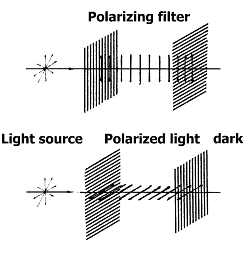

| Vectographs |
Principle of Polaroid Vectograph Prints
A Polaroid Vectograph print is a graphic medium based on the polarization of light.
Ordinary (unpolarized) light is made up of rays vibrating equally in all directions crosswise to their direction of travel. In the terms of vector geometry, these may be represented more simply as a pair of equal components vibrating at right angles to one another.
Light becomes polarized when one component is partially or wholly removed, so that the two components are no longer equal. This may be accomplished in a number of ways. One method is to pass it through a layer of oriented molecules which can absorb one component but not the other. This is the principle used in Polaroid sheet polarizers and in Polaroid Vectograph prints.
 In
a sheet polarizer, the direction in which polarized light is transmitted is
called its transmission axis or polarization axis. If two polarizers are superposed
with their polarization axes parallel, both will transmit the same component
and the pair will appear transparent. If they are superposed with their axes
at right angles - i.e., crossed with one another - the component transmitted
by each will be absorbed by the other and no light will get through.
In
a sheet polarizer, the direction in which polarized light is transmitted is
called its transmission axis or polarization axis. If two polarizers are superposed
with their polarization axes parallel, both will transmit the same component
and the pair will appear transparent. If they are superposed with their axes
at right angles - i.e., crossed with one another - the component transmitted
by each will be absorbed by the other and no light will get through.
In a Vectograph print, the image itself is a polarizer. Like other sheet polarizers it freely transmits one component of ordinary light. However, while the ordinary sheet polarizer absorbs virtually all of the other component, a Vectograph image absorbs this component in proportion to its density. Nearly all of this component will be absorbed in high density areas and only a small amount will be absorbed in low density areas.
Viewed through a polarizer with its polarization axis parallel, the Vectograph image is invisible. Through a polarizer with its axis of polarization at 90°, the image is seen in full contrast.
If two Vectograph images are superposed with their axes at 90° to one another, they may be viewed independently by looking through another polarizer. When this viewing polarizer (also called an analyzer) has its polarization axis parallel to that of one image, that image is invisible and the other is seen in full contrast as above. If the viewing polarizer is rotated 90°, the first image will be seen in full contrast and the second will disappear. Each image of such a pair is complete and continuous and is not changed or suppressed by the presence of the other image.
Polaroid Vectograph Film is a double-surfaced material with each surface a transparent layer of oriented molecules. The orientation axes of the two surfaces is 90° to one another. Polarizing images are formed on these two surfaces by the imbibition of a solution of light-absorbing molecules which have the ability to align themselves parallel to the oriented molecules.
For some purposes, different pictures can be printed on opposite sides of the Vectograph film and each viewed individually. These are sometimes called contrast or comparison Vectograph prints.
In three-dimensional (3-D) Vectograph prints the two images representing a stereoscopic pair are printed in stereoscopic register on opposite surface of a sheet of Vectograph film. The observer wears a viewer with polarizing left- and right eye filters, with their polarization axes at 90° to one another and each at 90° to the corresponding Vectograph image. Each eye then sees only the image intended for it, and the pair of images appears as a single, three-dimensional picture.
 |
|

| Back to the Stereoscopy.com FAQ Page |
